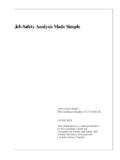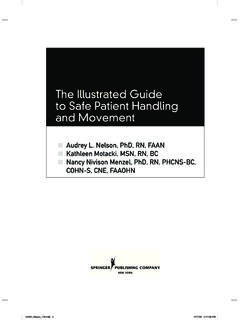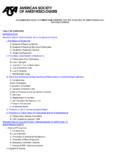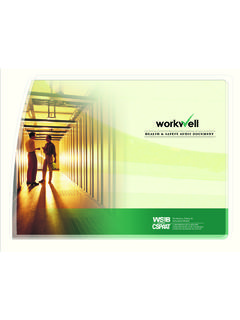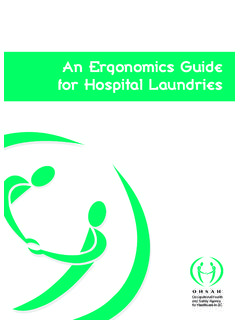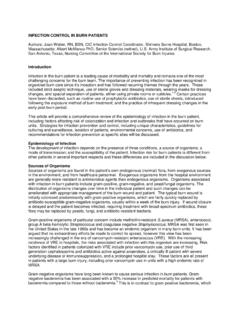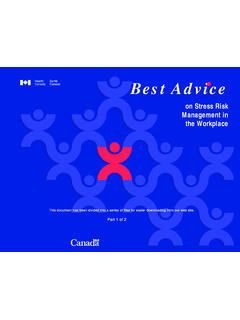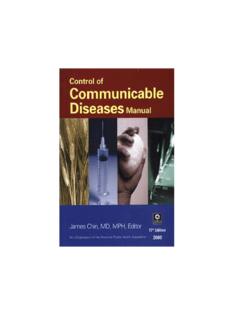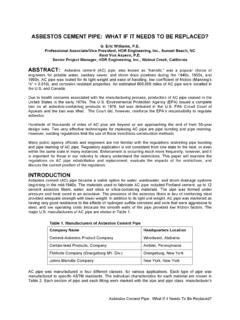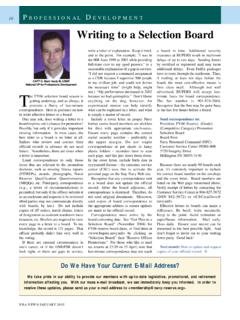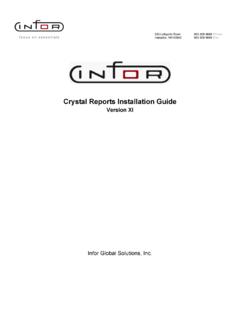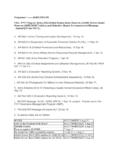Transcription of Selection and Use of Disinfectants - Christopher …
1 BCCDC Laboratory Services A Guide to Selection and Use of Disinfectants Selection and Use of Disinfectants Table of Contents Selection LOW LEVEL Phenolic Quaternary Ammonium INTERMEDIATE LEVEL Iodine And Iodophor HIGH LEVEL Hydrogen Peracetic Peracetic Acid and Hydrogen Special Consideration for Creutzfeldt-Jakob Disease (CJD)..11 Appendix 1 - Classes of Organisms Ranked in order of Susceptibility to Disinfectants 12 Appendix 2 - Disinfectant Uses, Advantages and Appendix 3 - Directions for Preparing and Using Chlorine-based 2 Selection and Use of Disinfectants DEFINITIONS Antiseptics - chemicals that kill microorganisms on living skin or mucous membranes.
2 Bactericidal - chemical agents capable of killing bacteria. Similarly agents that are virucidal, fungicidal or sporicidal are agents capable of killing these organisms. Bacteriostatic - Chemical agents that inhibit the growth of bacteria but do not necessarily kill them. Cleaning - the physical removal of foreign material, , dust, soil, organic material such as blood, secretions, excretions and microorganisms. Cleaning generally removes rather than kills microorganisms. It is accomplished with water, detergents and mechanical action. The terms decontamination and sanitation may be used for this process in certain settings, , central service or dietetics. Cleaning reduces or eliminates the reservoirs of potential pathogenic organisms. Critical items: instruments and devices that enter sterile tissues, including the vascular system. Critical items present a high risk of infection if the item is contaminated with any microorganisms.
3 Reprocessing critical items involves meticulous cleaning followed by sterilization. Decontamination: the removal of disease-producing microorganisms to leave an item safe for further handling. Disinfection: the inactivation of disease-producing microorganisms. Disinfection does not destroy bacterial spores. Disinfectants are used on inanimate objects in contrast to antiseptics, which are used on living tissue. Disinfection usually involves chemicals, heat or ultraviolet light. The nature of chemical disinfection varies with the type of product used. High level disinfection: High level disinfection processes destroy vegetative bacteria, mycobacteria, fungi and enveloped (lipid) and nonenveloped (non lipid) viruses, but not necessarily bacterial spores. High level disinfectant chemicals (also called chemical sterilants) must be capable of sterilization when contact time is extended. Items must be thoroughly cleaned prior to high level disinfection.
4 Intermediate level disinfection: Intermediate level Disinfectants kill vegetative bacteria, most viruses and most fungi but not resistant bacterial spores. Low level disinfection: Low level Disinfectants kill most vegetative bacteria and some fungi as well as enveloped (lipid) viruses ( , hepatitis B, C, hantavirus, and HIV). Low level Disinfectants do not kill mycobacteria or bacterial spores. Low level Disinfectants are typically used to clean environmental surfaces. 3 Selection and Use of Disinfectants Noncritical items: those that either come in contact with only intact skin but not mucous membranes or do not directly contact the patient. Reprocessing of noncritical items involves cleaning and/or low level disinfection. Sanitation: a process that reduces microorganisms on an inanimate object to a level below that of infectious hazard ( , dishes and eating utensils are sanitized).
5 Semicritical items: devices that come in contact with nonintact skin or mucous membranes but ordinarily do not penetrate them. Reprocessing semicritical items involves meticulous cleaning followed preferably by high-level disinfection. Sterilization: the destruction of all forms of microbial life including bacteria, viruses, spores and fungi. Items should be cleaned thoroughly before effective sterilization can take place. 4 Selection and Use of Disinfectants Selection CRITERIA Usually Disinfectants are "cidal" in that they kill the susceptible potential pathogenic agents. The Selection of a disinfectant should be based on the function the disinfectant is expected to perform, not necessarily on a sales pitch or on what you have always used. Ideally, a disinfectant should be broad spectrum (eliminates bacteria, viruses, protozoa, fungi and spores), nonirritating, nontoxic, noncorrosive and inexpensive.
6 Selection decisions should include effectiveness against the potential pathogenic agent, safety to people, impact on equipment, the environment, and expense. Disinfectant effectiveness depends on many factors. These include: Type of contaminating microorganism. Each disinfectant has unique antimicrobial attributes. Degree of contamination. This determines the quality of disinfectant required and time of exposure. Amount of proteinaceous material present. High protein based materials absorb and neutralize some chemical Disinfectants . Presence of organic matter and other compounds such as soaps may neutralize some Disinfectants . Chemical nature of disinfectant. It is important to understand the mode of action in order to select the appropriate disinfectant. Concentration and quantity of disinfectant. It is important to choose the proper concentration and quantity of disinfectant that is best suited to each situation.
7 Contact time and temperature. Sufficient time and appropriate temperature must be allowed for action of the disinfectant and may depend on the degree of contamination and organic matter load. Residual activity and effects on fabric and metal should be considered for specific situations. Application temperature, pH and interactions with other compounds must be considered. Toxicity to the environment and relative safety to people that may be exposed. Cost. 5 Selection and Use of Disinfectants LOW LEVEL Disinfectants Phenolic Disinfectants Phenol is commonly found in mouthwashes, scrub soaps and surface Disinfectants , and is the active ingredient found in household Disinfectants ( Lysol, Pine Sol). Phenolic Disinfectants are effective against bacteria (especially gram positive bacteria) and enveloped viruses.
8 They are not effective against nonenveloped viruses and spores. These Disinfectants maintain their activity in the presence of organic material. This class of compounds is used for decontamination of the hospital environment, including laboratory surfaces, and noncritical medical items. Phenolics are not recommended for semicritical items because of the lack of validated efficacy data for many of the available formulations and because the residual disinfectant on porous materials may cause tissue irritation even when thoroughly rinsed. Phenolic Disinfectants are generally safe, but prolonged exposure to the skin may cause irritation. The use of phenolics in nurseries is questioned because of toxicity to infants. Quaternary Ammonium Compounds The quaternary ammonium compounds are widely used as Disinfectants but are contraindicated as antiseptics. Their failure as antiseptics on skin and tissue was recognized following several outbreaks of infections associated with their use.
9 There are also reports of healthcare-associated infections associated with contaminated quaternary ammonium compounds used to disinfect patient-care supplies or equipment such as cystoscopes or cardiac catheters. The quaternaries are good cleaning agents but high water hardness and materials such as cotton and gauze pads may make them less microbiocidal because these materials absorb the active ingredients. As with several other Disinfectants ( , phenolics, iodophors) gram-negative bacteria have been found to survive or grow in these preparations. Quaternary ammonium (QA) Disinfectants contain NH4+. The labels often list a form of ammonium chloride (AC) such as alkyl aryl, benzyl, didecyl, dimethyl, ethylbenzyl, octyl or a combination thereof. Benzalconium chloride (BC) is a more tissue friendly QA than AC. QA Disinfectants are effective against Gram + and Gram - bacteria, and enveloped viruses.
10 They are not effective against non-enveloped viruses, fungi and bacterial spores. QA Disinfectants carry a very strong positive charge that makes good contact with negatively charged surfaces. This characteristic makes most very good cleaning agents. QA compounds are generally low in toxicity, but prolonged contact can be irritating. The quaternaries are commonly used in ordinary environmental sanitation of noncritical surfaces such as floors, furniture, and walls. 6 Selection and Use of Disinfectants INTERMEDIATE LEVEL Disinfectants Alcohols In the healthcare setting, "alcohol" refers to two water-soluble chemicals: ethyl alcohol and isopropyl alcohol. These alcohols are rapidly bactericidal rather than bacteriostatic against vegetative forms of bacteria (Gram + and Gram -); they also are tuberculocidal, fungicidal, and virucidal against enveloped viruses.
